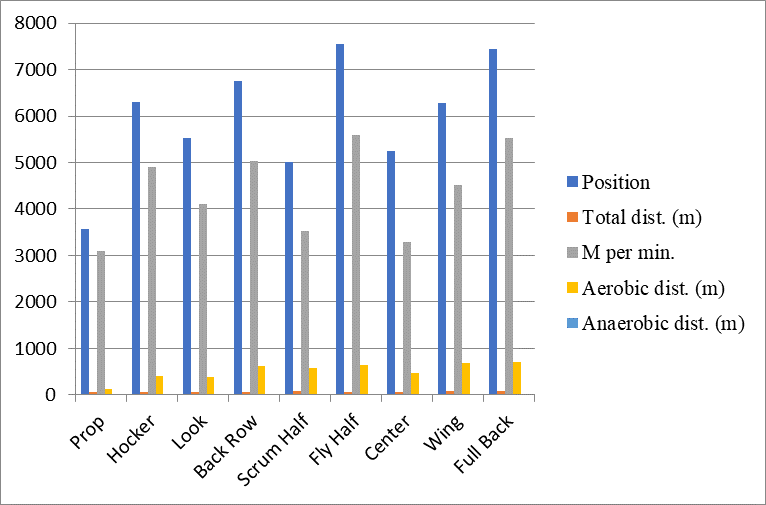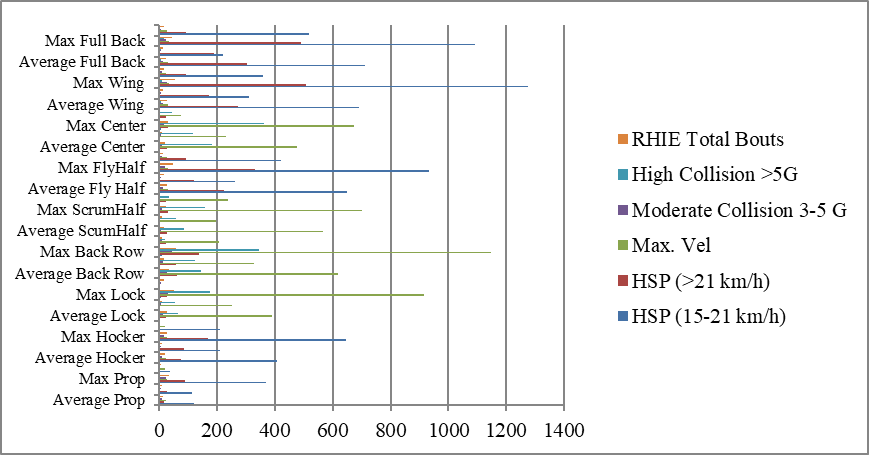Abstract
Through this study, we aim to analyse the effort in an international rugby match. We have proposed this analysis from the need to know the specific effort during the match so that we can then individually customise the training for each position. In order to supervise the team members, we used the Catapult Sport GPS system. This is a GPS which can be put in a special pocket of the vest or T-shirt of each player. The pocket is placed in the cervical area to reduce as much as possible the risk of accidents during the match. With the help of this equipment (supplied with software), one can determine, for each player, five ranges of speed (0 km/h - 6 km/h, 6 km/h -12 km/h, 12 km/h - 18 km/h, 18 km/h - 21 km/h and over 21 km/h), the distances covered, the highest and lowest pulse rates, the highest speed, the number of accelerations, the total distance covered at a speed higher than 21 km/h, the total number of collisions and the number of rough collisions (more powerful than 5G); by subtracting the latter from the former, one can find the number of moderate collisions. Given that we are the first owners of this kind of equipment, we would like to use it to obtain objective information for each monitored subject, by performing a complex analysis of all parameters of the effort made during a game, for each position and the whole team as well.
Keywords: RugbyeffortGPSmatch
Introduction
Monitoring represents an important aspect of the player evaluation during the match and training sessions alike; through permanent monitoring of the players, we can work out individualised types of training for improving certain deficiencies in the rugby players’ abilities.
Rugby 15s is a team game with intense physical and mental stress, which requires a combination of high effort, such as sprinting or ground game, with moments of average or even low effort such, as slow running. In professional rugby, performance occurs when players are able to optimally combine the physical capabilities to produce maximum efficiency.
Players must possess a series of high-level somatic and physical qualities in order to meet the requirements of modern rugby (Gabbett, Kelly, Ralph, & Driscoll, 2009). In this sport, players are separated into two fields: the advanced one and the three quarter one, each of them having different playing requirements. The advanced field is formed by 8 players assigned on three lines: no. 1 – Loose Head Prop, no. 2 – Hooker, no. 3 – Tight Head Prop, no. 4, 5 – Second Row, no. 6 – Blindside Flanker, no. 7 – Open Side Flanker, no. 8 – Back Row, no. 9 – Scrum Half, no. 10 Fly Half, no. 12 – Inside Centre, no. 13 – Outside Centre, no. 11 – Left Wing, no. 14 – Right Wing, no. 15 – Fullback.
The main actions of advanced players are conquering and maintaining possession in contact situations, which binds more players to involve in the action. From the specificity of this action, it results that players should be strong, with very well-defined muscle mass and with as low fat as possible, for being able to vigorously shift from an open game situation to a fixed moment (Bompa & Claro, 2009)
Problem Statement
The latest research in the field, achieved with the help of global positioning technology (McLellan, Lovell, & Gass, 2011; Suarez-Arrones et al., 2012), shows us the measurement of different variables by position, in both training and competition. This offers us specific key information on each player’s profile, which will provide the team success. Despite this, only a few studies reflect the direct relation between physical abilities, anthropomorphic characteristics and the performance indicator in competition.
Research Questions
Rugby is a fast sport, with moments of intense physical activity for taking/keeping possession of the ball alternating with periods of rest, each of these having different durations (Drewett, 2010).
Game characteristics include sprints at maximal and submaximal speeds, quick changes of direction, jumps, tackles and the fight for the ball. These activities force the anaerobic system to produce the required energy, having in mind that it can only produce energy for a short period of time (Joyce & Lewindon, 2014)
Purpose of the Study
The purpose of this study is to define specific effort by position, during an official match. We aim to establish the priorities that each position will have to observe during training so that maximum training performance can be achieved. With this type of test, we will collect relevant real-time information that we can analyse for each position.
Research Methods
In this study, we used the Catapult GPS technology, being the first ones to do it. We aimed to study the variation in effort during competition, so, at the 2017 European Championship Under 20 held in Bucharest, we recorded the parameter variation during the three games of this competition. The parameters we recorded and analysed after these games were elected to help us plan the training in the future. Among the recorded parameters for this age category, we mention: total distance, meters per minute, aerobic distance, anaerobic distance, high-speed distance, maximum velocity, heavy and moderate collisions, RHIE (repeated high-intensity effort) bouts.
Catapult GPS technology gives us the privilege to record live data, which allows us to know the exercise capacity of players and make changes in the existing set piece on the field. This equipment is made up of four elements: vest, GPS device, antenna for tracking and laptop.
After completing these games, the recorded data were analysed for each position and game. Below, we present the results from this study.
Findings

The collected data are shown in Tables
Analysis of the effort according to the areas of effort has revealed that, for the forwards, the largest part of the total distance was performed in the aerobic area, and a small distance, in the anaerobic area. As for the backs, the value of the anaerobic area has increased, which is due to the specificity of actions per position.

According to the running speed (recorded in meters) developed between 15-21 km/h, the highest value is recorded for the wing position, with 1276, and the lowest value, for the prop position. The highest running volume at speeds above 21 km/h is recorded by the wing, with 509 m, while the opposite value is recorded by the prop, with 0 m.
Finally, we make references to collisions recorded during the game, because rugby is a contact sport, and collisions represent a large part of the game. So, the maximum number of heavy collisions is recorded for the centre position, and the lowest number of heavy collisions is recorded by the prop and hooker, with 0. At moderate collisions, the highest (maximum) number was recorded by the back row, and the centre had just two moderate collisions.
For the RHIE bouts, the highest number was recorded by the back row, with 57, and the lowest value was 0, recorded by the centre and scrum half. Figure
Conclusion
We end by stating that high volumes of running are recorded in both compartments, especially the backs.
In terms of aerobic-anaerobic ratio by effort zone, the highest volume is in the aerobic zone, so we can state that rugby is a collective sport with aerobic preponderance, with short intervals of intervention of the anaerobic system.
Regarding running speed (expressed in meters), the results have shown that the highest running speed was recorded by the backs, on the wing and full back positions, while the lowest values where recorded by the forwards, on the prop position.
As for ground actions or heavy collisions, the centre is the position with the highest values, while the prop and hooker record the lowest values. Moderate collisions are recorded on the back row, and the opposite value is recorded by the centre.
In the last analysis, we aimed at the maximal actions, where we observed a higher value for the back row position.
We conclude by specifying that this analysis will help us in the future for an objective periodisation of conditioning, which means an exact analysis of the effort during competition.
Acknowledgments
We would like to express our gratitude to the Romanian Rugby Union for their unconditional support.
References
- Bompa, T., & Claro, F. (2009). Periodization in rugby. UK: Meyer & Meyer Sport.
- Joyce, D., & Lewindon, D. (2014). High performance training for sports (5th ed.). Human Kinetics.
- Drewett, P. (2010). Rugby: Steps to success (2nd ed.). Champaign, IL: Human Kinetics.
- Gabbett, T., Kelly, J., Ralph, S., & Driscoll, D. (2009). Physiological and anthropometric characteristics of junior elite and sub-elite rugby league players, with special reference to starters and non-starters. Journal of Science and Medicine in Sport, 12(1), 215-222.
- McLellan, C. P., Lovell, D. I., & Gass, G. C. (2011). Performance analysis of elite rugby league match play using global positioning systems. Journal of Strength and Conditioning Research, 25(6), 1703-1710.
- Suarez-Arrones, L., Portillo, J. J., Gonzalez-Rave, J., Munoz, V. D., Sanchez, F., Suarez, L., … Hurtado-Sanchez, F. (2012). Match running performance in Spanish elite male rugby union using global positioning system. Isokinetics and Exercise Science, 20(2), 77-83.
Copyright information

This work is licensed under a Creative Commons Attribution-NonCommercial-NoDerivatives 4.0 International License.
About this article
Publication Date
16 February 2019
Article Doi
eBook ISBN
978-1-80296-054-9
Publisher
Future Academy
Volume
55
Print ISBN (optional)
-
Edition Number
1st Edition
Pages
1-752
Subjects
Sports, sport science, physical education
Cite this article as:
Dreve, A., & Marinescu, G. (2019). Identification Of Effort Parameters In A Rugby Match With The Gps. In V. Grigore, M. Stănescu, M. Stoicescu, & L. Popescu (Eds.), Education and Sports Science in the 21st Century, vol 55. European Proceedings of Social and Behavioural Sciences (pp. 621-627). Future Academy. https://doi.org/10.15405/epsbs.2019.02.77
